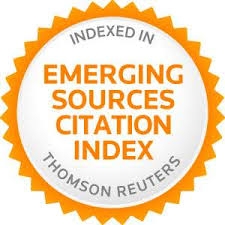La triangulación analítica como recurso para la validación de estudios de encuesta recurrentes e investigaciones de réplica en Educación Superior
Resumen
Palabras clave
Texto completo:
PDFReferencias
Arias, M. (2000). Triangulación metodológi-ca: sus principios, alcances y limitaciones. Enfermera, vol. XVIII, (1), 37-57.
Arnal, J., Del Rincón, D. y Latorre, A. (1994). Investigación educativa. Fundamentos y metodología. Barcelona: CEAC.
Bericat, E. (1998). La integración de los métodos cuantitativo y cualitativo en la investigación social. Significado y medida. Barcelona: Ariel.
Blaikie, N. (1991) A critique of the use of triangulation in social research, Quality and Quantity, 25, 115-136
http://dx.doi.org/10.1007/BF00145701
Bolívar Botía, A., Fernández Cruz, M. & Molina Ruiz, E. (2004, Noviembre). Inves-tigar la identidad profesional del profesora-do: Una triangulación secuencial. Forum Qualitative Sozialforschung / Forum: Qualitative Social Research [On-line Journal], 6(1), Art. 12. Disponible en: http://www.qualitative-research.net/fqs-texte/1-05/05-1-12-s.htm [Fecha de acceso: octubre/15/2006].
Brannen, J. (Ed.) (1992). Mixing methods: qualitative and quantitative approaches. Aldershot: Avebury.
Bryman, A. (1988). Quantity and quality in social research. London, New York: Routledge.
http://dx.doi.org/10.4324/9780203410028
Cea D'Ancona, M. A. (1996). Metodología Cuantitativa. Estrategias y técnicas de investigación social (1ª edición). Madrid: Editorial Síntesis.
Chatterji, M. (2005). Evidence on 'What works': an argument for extended-term mixed-method (ETMM) Evaluation Des-ings. Educational Research 34(5), 14-24.
http://dx.doi.org/10.3102/0013189X034005014
Cohen, J. A. (1960). Coefficient of agreement for nominal scales. Educational and Psychological Measurement, 20, 37-46.
http://dx.doi.org/10.1177/001316446002000104
Cohen, L. y Manion, L (1994). Métodos de investigación educativa. Madrid. La Muralla.
Cook, T. D. & Reichardt, Ch. S. (1986). Métodos cualitativos y cuantitativos en investigación evaluativa. Madrid: Morata.
Cowman S. (1993). Triangulation: a mean of reconciliation in nursing research. Journal of Acvanced Nursing, 18, 788-792.
http://dx.doi.org/10.1046/j.1365-2648.1993.18050788.x
Cresswell, J. W. (1994). Research design. Qualitative and quantitative approaches. Thousand Oaks: Sage.
Creswell, J.W. (2002). Educational Re-search: planning, conducting, and evaluating quantitative and qualitative research. New Jersey: Merrill/ Prentice Hall.
Denzin, N. K. (1970). The research act. Chi-cago: Aldine Publishing.
Denzin, N. K. (1975). The research act. A theoretical introduction to sociological methods. New York: McGraw Hill.
Denzin N. K. (1989). Strategies of Multiple Triangulation. The Research Act: A theoretical Introduction to Sociological Methods. New York: McGraw Hill.
Eggan, F. (1975). La Antropología Social y el método de la comparación controlada. En Llobera, J. (Comp.). La Antropología como ciencia. Barcelona: Anagrama, 179-202.
Erickson, F. & Gutiérrez, J.K. (2002). Culture, rigor and science in educational re-search. Educational Researcher, 31 (8), 21-24.
http://dx.doi.org/10.3102/0013189X031008021
Erzberger, C. (1998). Zahlen und Wörter. Die Verbindung quantitativer und qualitativer Daten undMethoden im Forschungspro-zeß. Weinheim: Deutscher Studien Verlag.
Erzberger, C. & Prein, G. (1997). Triangulation: validity and empirically based hypoth-esis construction. Quality & Quantity, 31(2), 141-154.
http://dx.doi.org/10.1023/A:1004249313062
Feuer, M., Towne, L. & Shavelson, R.J. (2002). Scientific culture and educational research. Educational Researcher, 31 (8), 4-14.
http://dx.doi.org/10.3102/0013189X031008004
Fleiss, J.L. (1981). Statistical methods for rates and proportions. Nueva York: Wiley.
Fleiss, J.L.; Cohen, J. & Everitt, B.S. (1969). Large-sample standard errors of kappa and weighted kappa. Psychological Bulletin, 72, 295-300.
http://dx.doi.org/10.1037/h0028106
Flick, U. (1998). An introduction to qualitative research. Thousand Oaks, London, New Delhi: Sage.
Flick, U. (2004). Triangulation. Eine Einführung. Weinheim: Deutscher Studien Verlag.
http://dx.doi.org/10.1007/978-3-322-97512-6
Glasser, B. G. & Strauss, A. L. (1967). The discovery of grounded theory: Strategy for qualitative research. Hawthorne, NY: Aldine Publishing Company.
Goetz, J. P. & LeCompte, M.D. (1991). Qualitative research in social studies education. In J.P. Shaver (Ed.), Handbook of re-search on social studies teaching and learning, a project of the National Council for the Social Studies. New York: MacMillan Publishing Co, 56-67.
Guba, E.G. & Lincoln, Y.S. (1985). Naturalistic Inquiry. Beverly Hills. Sage.
Gürtler, L. & Gahleitner, S. B. (2005, September). Conference Report: Fifth Annual Meeting of Qualitative Psychology "Qualitative and Quantitative Approaches to Learning and Instruction" / First Meeting of the Special Interest Group #17 of the European Association for Research in Learning and Instruction (EARLI) "Mixed Methodology in Psychological Research". Forum Qualitative Sozialforschung / Forum: Qualitative Social Research [On-line Journal], 6(3), Art. 33. Available at: http://www.qualitative-research.net/fqs-texte/3-05/05-3-33-e.htm [Date of Access: octubre/15/2006].
Jaeger, R.M. (Ed.) (1988). Complementary methods for research in education. Washington, D.C.: American Educational Re-search Association.
Janesick, V. (1994). The dance Qualitative Research Design. In Denzin, N.K. & Lincoln, Y.S. (Eds.), Handbook of qualitative research. London: Sage Publication, 209-219.
Johnson, R.B. & Turner, L.A. (2003). Data collection strategies in mixed methods re-search. In Abbas Tashakkori & Charles Teddlie (Dirs.), Handbook of mixed methods in social & behavioral research. Thou-sand Oaks: Sage, 297-319.
Johnson, B. & Onwuegbuzie, A. (2004). Mixed Methods Research: A research paradigm whose time has come. Educational Research 33(7), 14-26.
http://dx.doi.org/10.3102/0013189X033007014
Johnstone, P. L. (2004). Mixed Methods, Mixed Methodology in Health Services Research. Practice Qualitative Health Research, 14: 259 - 271.
http://dx.doi.org/10.1177/1049732303260610
Kelle, U. (2001, February). Sociological Explanations between Micro and Macro and the Integration of Qualitative and Quantita-tive Methods . Forum Qualitative Sozi-alforschung / Forum: Qualitative Social Research, 2(1). Available at: http://qualitative-research.net/fqs/fqs-eng.htm [Date of ac-cess: March, 02, 2005] .
Kelle, U. & Erzberger, Ch. (1999). Integration qualitativer und quantitativer Methoden: methodologische Modelle und ihre Bedeutung für die Forschungspraxis. Koelner Zeitschrift fürSoziologie und Sozi-alpsychologie, 51, 509-531.
Kelle, U. & Erzberger, Ch. (2003). Making inferences in mixed methods: The rules of integration. In Abbas Tashakkori & Charles Teddlie (Hrsg.), Handbook of mixed methods in social & behavioral research. Thou-sand Oaks: Sage, 457-488.
Landis, J.R. & Koch, G.G. (1977). An application of hierarchical kappa-type statistics in the assessment of majority agreement among multiple observer. Biometrics, 33, 363-374.
http://dx.doi.org/10.2307/2529786
Levi-Strauss, C. (1975). Las tres fuentes de la reflexión etnológica. En J. Llobera, (Comp.): La Antropología como ciencia. Barcelona: Anagrama, 15-24.
Mair, L. (1978). Introducción a la Antropología Social. Madrid: Alianza.
Massey, A. (1999). Methodological triangulation, or how to get lost without being found out. En Massey, A. & Walford, G. (Eds.). Explorations in methodology, Studies in Educational Ethnography (vol.2, pp.183-197). Stamford: JAI Press. Disponible en: http://www.freeyourvoice.co.uk/htm/triangulation1.htm [junio,07, 2004].
Morgan, G. (Ed.) (1983). Beyond method: strategies for social research. Beverly Hills: Sage.
Morse, J.M. (1991). Approaches to Qualitative-Quantitative Methodological Triangulation. Methodology Corner. Rev. Nursing Research, 40(1), 23-45.
Onwuegbuzie, A.J. & Leech N. L. (2005). On Becoming a Pragmatic Researcher: The Importance of Combining Quantitative and Qualitative Research Methodologies. Inter-national Journal of Social Research Methodology, Vol. 8(5), 375 - 387.
http://dx.doi.org/10.1080/13645570500402447
Onwuegbuzie, A. J. & Teddilie's, C. (2003). A framework for analyzing data in mixed methods research. In In Abbas Tashakkori & Charles Teddlie (Dirs.), Handbook of mixed methods in social & behavioral re-search. Thousand Oaks: Sage, 351-383.
Ragin, C. (1987).The comparative method: moving beyond qualitative and quantitative strategies. Berkeley: University of California Press.
Ragin, C. & Becker, H. (1992). What is a case? Exploring the foundations of social inquiry. New York: Cambridge University Press.
Ramos, J. (1996). Jano y el ornitorrinco: aspectos de la complejidad social. En A. Pérez & I. Sánchez, (Eds.). Complejidad y Teoría Social. Madrid: CIS, 23-52.
Rodríguez, C. (2003). Métodos y estrategias de integración de los paradigmas en investigación educativa. En L. Herrera; O. Lorenzo; M.C. Mesa & I. Alemany (Coords.), Intervención psicoeducativa: una perspectiva multidisciplinar. Granada: Grupo Editorial Universitario, 35-52.
Smith, J.K. & Heshusius, L. (1986). Classing down the conversation: The end of the quantitative-qualitative debate among educational inquirers. Educational Research, 15 (1), 35-45.
Silverman, D. (1993). Interpreting Qualitative Data. London: Sage.
Spradley, J.P. (1980). The ethnographic interview. New York: Holt, Rinehart & Winston.
Vidich, A.J. & Shapiro, G. (1955). A comparison of participant observation and survey data. American Sociological Review, 20, 28-33.
http://dx.doi.org/10.2307/2088196
Walkers, R. & Evers, C.W. (1988). The epistemological unity of educational research, In J.P. Keeves (Ed.). Educational research methodology and measurement: An international handbook. Oxford: Pergamon Press, 145-175
Zelditch (1962). Some methodological problems of field studies. American Journal of Sociology, 67, 566-576.
http://dx.doi.org/10.1086/223194
Enlaces refback
- No hay ningún enlace refback.


